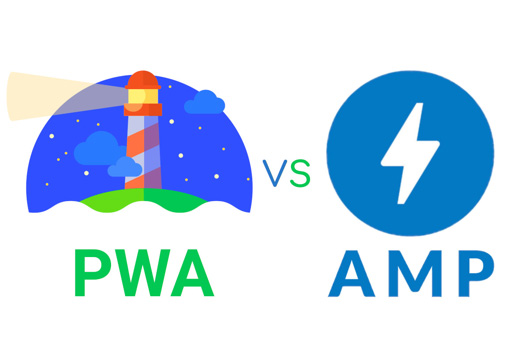Both PWA and AMP were designed to enhance a user’s web experience while using a mobile device compatible platform. PWAs and AMPs are methods of displaying web pages on mobile devices. But users often get confused between PWA and AMP. Let’s help you understand the difference between PWA and AMP.
What is PWA?
PWA stands for Progressive Web App. It is mobile website experience designed to look, feel, and work the way native mobile apps do by accessing its web pages on a browser.
Twitter is one of the major companies using PWAs. To install the app, you open the web version on your phone and add it to your home screen. When you open Twitter from the home screen icon, you will be opening it as a progressive web app.
PWAs are a highly responsive and easily shareable solution, which can work offline. They store HTML and CSS files in the browser cache and archive them with service workers. This makes it possible to use the web page offline.
Service workers are javaScript code components which play the role of a proxy between the network and the browser. When you open a web page for the first time, service workers store the necessary data in the browser cache. When you open it for the second time, service workers retrieve this data from the cache even before the app checked network availability.
Not only do they provide the ability to work offline but also they greatly boost the response time. Service workers also manage push notifications.
The Manifest file is a JSON file containing all the information about your app. For instance, it contains data about the home screen icon of your PWA, its short name, color palette, or theme. If you are using the Chrome browser on an Android phone, the manifest file will trigger the automatic installation of the PWA onto your phone.
The secure HTTPS protocol is an absolute must if you develop a progressive web app. While service workers make the concept of a PWA possible, they are vulnerable to network errors or breaches. Service workers can intercept network requests and modify responses. To ensure data security and network security, the secure protocol needs to be used.
What is AMP?
AMP stands for accelerated mobile page. It was introduced by Google in 2015 to create faster loading web pages for mobile devices. It’s a mobile-friendly web page, which is designed to be loaded instantly. That language is a stripped-down version of HTML and CSS which restricts the use of JavaScript. These pages are hosted on a CDN, which delivers a cached version of the page when it’s visited by a user. The three essential components of AMPs are AMP HTML, AMP Components, and the AMP Cache.
AMP HTML is a simplified version of regular HTML. AMP HTML does not allow some tags and elements of HTML (for example, forms).
AMP Components are the scripts that enable you to do without JavaScript. The idea of AMP is to get rid of all JavaScript scripts as make pages load more slowly.
The AMP Cache is a proxy-based content delivery network which fetches and caches page content. AMP Cache enables you as an app owner to easily introduce page updates. It optimizes and, if needed, modifies the AMP.
Conclusion
AMPs and PWAs both help reduce page load time. While AMPs may be slightly more effective in terms of loading speed than PWAs, the difference between AMP and PWA loading times is barely noticeable.Both technologies are actively supported by Google. There is a PWA page on Google Developers and an AMP page on Google Developers as well.
By using a PWA you do not feel like you are using a web page. PWAs look and feel like a mobile app.By using AMPs, you are well aware that you are using a web page because it looks the same.
In the case of PWAs, the application code is written either from scratch or with some parts of the existing code.In the case of AMPs, the existing code of a web page is stripped of unnecessary CSS and JS so that the web page loads faster.
PWAs offer a much better user experience. They have push-notifications, a home screen icon, and no browser tabs.PWAs can be used when the network connection is down.
AMPs offer a slightly improved user experience since the page loads faster than a regular page. Still, this is the only UX advantage that they offer. Unlike PWAs, AMPs cannot work offline.
Both are powerful tools to improve site performance and user experience. You can choose either of two technologies or simply implement both to experience the best of both. The choice is yours.

6 thoughts on “PWA vs AMP: How to Choose?”
Valuable info. Fortunate me I found your website unintentionally, and I am surprised why this accident did not came about earlier! I bookmarked it. Phaidra Cirillo Ynez
I conceive other website proprietors should take this web site as an model, very clean and great user pleasant layout. Tobye Stanton Torey
Many thanks very valuable. Will share website with my pals. Hester Collin Alissa
I think this is a real great blog article. Really looking forward to read more. Much obliged. Savina Hector Mateya
I enjoyed reading this. Nice read. I enjoyed reading this. This information is magnificent. Viviyan Dionysus Odrick
Terrific article! That is the type of information that are supposed to be shared around the internet. Amabel Foss Pulling